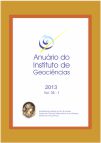Environmental Conditions and Pollen Record of a Nearly 40,000 Years B.P. old Sediment Level Obtained in the Lagoa de Itaipu, State of Rio de Janeiro
DOI:
https://doi.org/10.11137/2013_2_91_95Abstract
The lake of Itaipu is located in the central coastal plain, northern to the city of Rio de Janeiro. It started during the late Pleistocene upon an elder swampy underground. During its aging into the Holocene period, the vegetation changed between the domains of forests, savannas and hydrophytes. A 160 cm long sediment core was obtained and a sample was selected at the basis of the core for pollen analysis, dated of 38,490 À 940 non-calibrated years B.P.. Pollen analysis identified 32 pollen types leading to characterize four types of vegetation: the rain forest vegetation, the forest pioneer vegetation, the herbaceous swamp vegetation and the field vegetation. Pollen grain frequency and concentration showed that at this time the area was covered with a mosaic of plant communities, that the lake was not yet installed, and that a humid environment provided the maintenance of high plant diversity.Downloads
Download data is not yet available.
Downloads
Published
2013-01-01
How to Cite
Barth, O. M., Bartholomeu, R. L. and Barros, M. A. de (2013) “Environmental Conditions and Pollen Record of a Nearly 40,000 Years B.P. old Sediment Level Obtained in the Lagoa de Itaipu, State of Rio de Janeiro”, Anuário do Instituto de Geociências. Rio de Janeiro, BR, 36(2), pp. 91–95. doi: 10.11137/2013_2_91_95.
Issue
Section
não definida
License
This journal is licensed under a Creative Commons — Attribution 4.0 International — CC BY 4.0, which permits use, distribution and reproduction in any medium, provided the original work is properly cited.















